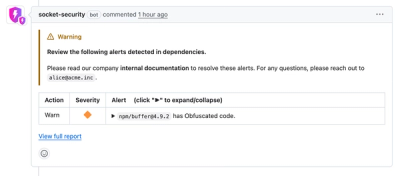
Security News
Crates.io Users Targeted by Phishing Emails
The Rust Security Response WG is warning of phishing emails from rustfoundation.dev targeting crates.io users.
@dinazor/plugins
Advanced tools

Flot is a Javascript plotting library for jQuery.
Read more at the website: http://www.flotcharts.org/
Take a look at the the examples in examples/index.html; they should give a good impression of what Flot can do, and the source code of the examples is probably the fastest way to learn how to use Flot.
Just include the Javascript file after you've included jQuery.
Generally, all browsers that support the HTML5 canvas tag are supported.
For support for Internet Explorer < 9, you can use Excanvas excanvas, a canvas emulator; this is used in the examples bundled with Flot. You just include the excanvas script like this:
<!--[if lte IE 8]><script language="javascript" type="text/javascript" src="excanvas.min.js"></script><![endif]-->
If it's not working on your development IE 6.0, check that it has support for VML which Excanvas is relying on. It appears that some stripped down versions used for test environments on virtual machines lack the VML support.
You can also try using Flashcanvas, which uses Flash to do the emulation. Although Flash can be a bit slower to load than VML, if you've got a lot of points, the Flash version can be much faster overall. Flot contains some wrapper code for activating Excanvas which Flashcanvas is compatible with.
You need at least jQuery 1.2.6, but try at least 1.3.2 for interactive charts because of performance improvements in event handling.
Create a placeholder div to put the graph in:
<div id="placeholder"></div>
You need to set the width and height of this div, otherwise the plot library doesn't know how to scale the graph. You can do it inline like this:
<div id="placeholder" style="width:600px;height:300px"></div>
You can also do it with an external stylesheet. Make sure that the placeholder isn't within something with a display:none CSS property - in that case, Flot has trouble measuring label dimensions which results in garbled looks and might have trouble measuring the placeholder dimensions which is fatal (it'll throw an exception).
Then when the div is ready in the DOM, which is usually on document ready, run the plot function:
$.plot($("#placeholder"), data, options);
Here, data is an array of data series and options is an object with settings if you want to customize the plot. Take a look at the examples for some ideas of what to put in or look at the API reference. Here's a quick example that'll draw a line from (0, 0) to (1, 1):
$.plot($("#placeholder"), [ [[0, 0], [1, 1]] ], { yaxis: { max: 1 } });
The plot function immediately draws the chart and then returns a plot object with a couple of methods.
First: it's pronounced with a short o, like "plot". Not like "flawed".
So "Flot" rhymes with "plot".
And if you look up "flot" in a Danish-to-English dictionary, some of the words that come up are "good-looking", "attractive", "stylish", "smart", "impressive", "extravagant". One of the main goals with Flot is pretty looks.
In order to have a useful, functional example of time-series plots using time zones, date.js from timezone-js (released under the Apache 2.0 license) and the Olson time zone database (released to the public domain) have been included in the examples directory. They are used in examples/axes-time-zones/index.html.
FAQs
Unknown package
We found that @dinazor/plugins demonstrated a not healthy version release cadence and project activity because the last version was released a year ago. It has 1 open source maintainer collaborating on the project.
Did you know?

Socket for GitHub automatically highlights issues in each pull request and monitors the health of all your open source dependencies. Discover the contents of your packages and block harmful activity before you install or update your dependencies.

Security News
The Rust Security Response WG is warning of phishing emails from rustfoundation.dev targeting crates.io users.

Product
Socket now lets you customize pull request alert headers, helping security teams share clear guidance right in PRs to speed reviews and reduce back-and-forth.

Product
Socket's Rust support is moving to Beta: all users can scan Cargo projects and generate SBOMs, including Cargo.toml-only crates, with Rust-aware supply chain checks.